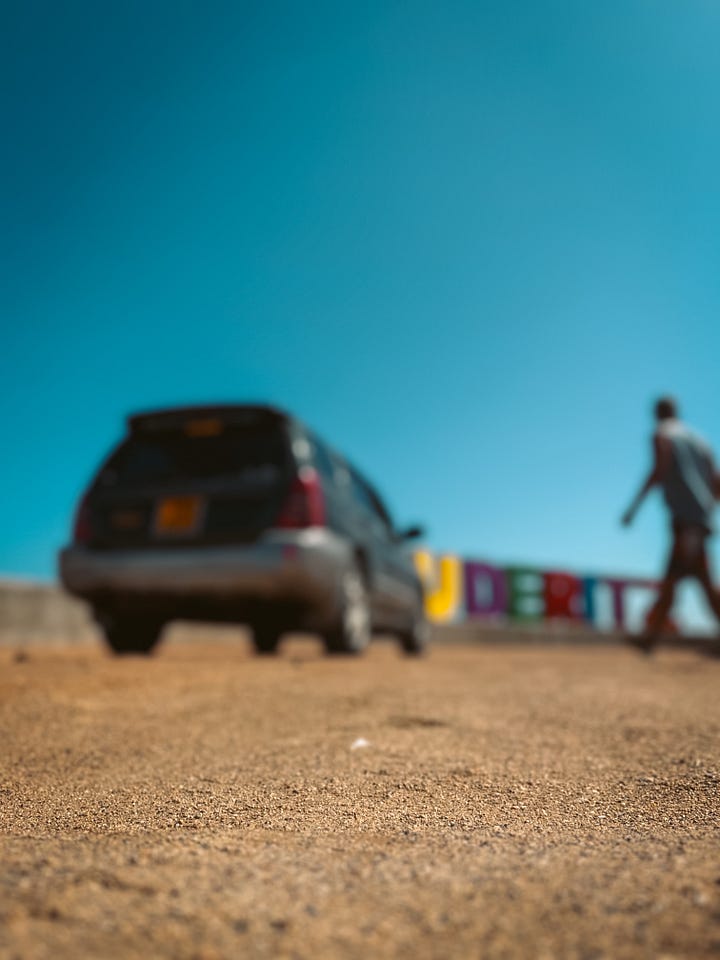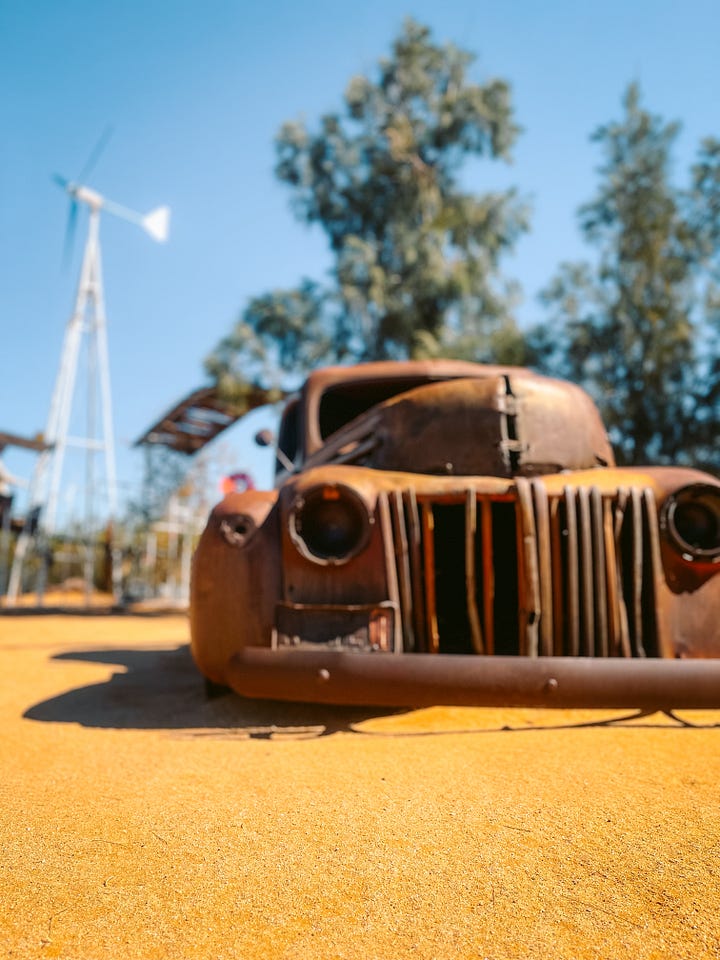“Not everybody is allowed a complex identity. Throughout history, individuals and entire communities have been systematically stripped of their personhood, idiosyncrasies, often to make them easier to demean, denigrate and subjugate - and, in some cases, eradicate.” - Africa is Not a Country, Dipo Faloyin


We spent the last three weeks of our time in Africa in Namibia. Namibia is an interesting place… The title of this article “blurred lines” came to me while I was learning about Namibia’s violent past. For many survivors and people who grow up in former colonies, their ancestral past and ability to define themselves is often blurry. False narratives often permeate generations, until fiction becomes fact, and the truth becomes fuzzy. My photos, which fit nicely with the theme “blurred lines”, are intentionally blurry. Namibia is a place of the most amazing and otherworldly colours and textures, and in a way, there is no need to see the details when all you need to see are the colours…


As soon as you arrive in Namibia you notice the German influence and the presence of the German language on place names and other things like food menus, signs, etc. This is not because Namibia receives so many German tourists every year, and wants to make them feel welcome, it’s the leftovers of Namibia’s colonial past. The German colonization of what became German South West Africa commenced in 1884 and ended with German forces’ surrender to the Union of South Africa in July 1915. Colonialism has inflicted lasting wounds on Namibia. The book Africa is Not a Country by Dipo Faloyin was the main source for the information in this article, a book that we both read while on the road and recommend everyone to read. If there is one thing we have learned during our ten months in Africa, as well as making a conscious effort to inform ourselves on the topic, it’s that colonialism has had a huge influence on the lives of Africans. Economic policies adopted by Europeans destroyed the colonies, and left Africa damaged economically, politically, and culturally. Africa's traditional lifestyles and culture were destroyed, and genocides were committed.


The first genocide of the twentieth century
Nine of the most arbitrary states in the world are in Africa - Namibia is one of them. Modern Africa was divided against its will to be a divided thing. A continent of fifty four houses built on sand. Former German South West Africa, a large semi-arid region in Southern Africa, is known today as Namibia. Controlled from 1884, Namibia only gained independence in 1990. With a decent climate, around 30,000 Germans settled in the colony, occupying land through (you guessed it) OCCUPATION. Through a series of disingenuous treaties, the Germans were able to confiscate a significant amount of land, while destroying the livelihoods of local cattle herders, like the Herero and Nama, in the process.


After the theft of their land, the Herero and Nama people revolted in an attempt to regain some control of their property. This erupted in a conflict in 1904, where dozens of the German settlers were killed. As punishment for the uprising, the Germans appointed an experienced colonial general with a reputation for violence. His solution was genocide - he officially declared the systematic extermination of the local population.
“My intimate knowledge of many Central African nations has everywhere convinced me of the necessity that the Negro does not respect treaties but only brute force.” - Colonel Lothar von Trotha


Many settlers opposed the colonal’s force, but more from an economic point of view, not necessarily out of humanitarian reasons - the Herero were especially good cattle breeders. The violence against the local population became the first genocide of the twentieth century, and what the UN described in 1985 as one of the worst massacres in history. 80% of the Herero population and 50% of the Nama people were murdered by the German colonial army - the death toll was in the range of 100,000. Thousands died of dehydration, after many being forced to flee into the desert, and the Germans also poisoned water wells to ensure any survivors could not make their way back to their ancestral lands alive.


Others were taken to concentration camps, where 75% of the people died. While the prisoners at the death camps were still alive, they were subject to racist scientific experiments, barely fed, and many were worked to death. The Herero women were required to collect the skulls of hundreds of victims, then boil, clean, and finally shave them using shards of glass. The skulls were then sent to Germany as part of experiments that aimed to prove that black people were part of a biologically inferior race. The Germany believed in a now-discredited pseudoscience that proposed you could determine the extent of a person’s intelligence by measuring the shape of their skull. Historians even believe that these experiments on the remains of the Herero and Nama acted as a precursor to the Nazi ideology of race purity.


Skeletons and skulls were collected like trophies throughout German colonies such as Namibia, Rwanda, Burundi, and Togo. Aside from justifying their beliefs in European racial superiority, the stolen remains of the victims of colonial rule served further purposes. Firstly, to humiliate local populations into submission by showing them that even in death they could not escape. But also to make money, as they were sold to institutions willing then, as they are now, to put them on display.


In 2021, the German government, in an attempt to “face up to their historic and moral responsibility to shine a light and work on Germany’s historic past”, set out concrete plans to return what could be up to 7,000 pillaged artefacts within the year. Part of their restitution efforts include the physical remains of thousands of people taken to Europe for racist scientific experiments. It is estimated that two German scientists alone amassed a collection that featured the remains of 15,000 people. Some of the skulls from the Herero genocide went to the American Museum of Natural History, where they still remain and where recent research has been carried out on them. Two dozen skulls were repatriated to Namibia in 2018, while thousands still remain in Germany.


The genocidal atro- cities committed by German colonial troops from 1904–1908, sanctioned by General Lothar von Trotha’s 1904 and 1905 orders to exterminate the Herero and Nama, significantly changed the course of history and socio-economic status of the people who lived in Namibia at that time, as well as generations of their descendants. Unsurprisingly, Germany has taken the position that it bears no legal responsibility for the first genocide of the 20th century, only a moral and political one. Genocide does not end once it has been committed, but lives on in experiences and memories, as well as the shape of communities and their level of economic and political power or weakness. Solidified in this way, genocide stops being an event and turns into a structure. In Namibia, this structure is truly stunning: an estimated 18,000 to 20,000 German-speakers, primarily descendants of those who arrived before South African occupation, own most of the agricultural land in a country of 2.5 million. Settling colonial accounts is particularly difficult against this backdrop of drastic inequality. Germany, what are you waiting for?


Thanks for reading our postcard from Namibia.
Don’t forget to subscribe, if you haven’t already…




